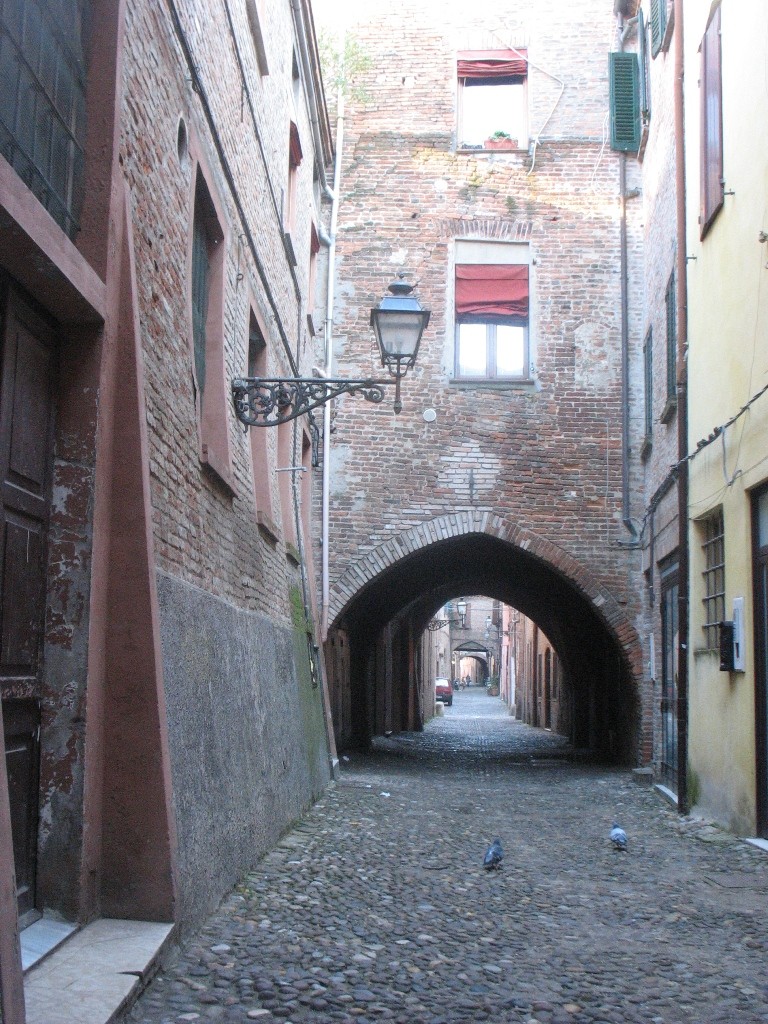Ferrara: Medieval Beauties (1)
For a guided tour for this wonderful town, I thought it better to follow the historic development of the urban fabric. In our route for Ferrara, therefore, we will first discover the medieval beauties, going on then to the heart of the city and finally ending with the graceful Renaissance area. A perfect starting point for our itinerary would be Piazza Travaglio, a wide square basically devoid of any cultural attraction but whose main quality is the fact of being adjacent to a wide car park, the so-called Piazzale Kennedy. Having crossed then the square, the wide Corso Porta Reno will lead you towards the city centre. However, the street soon becomes narrower, as a proof of the fact that you are penetrating into the medieval area of the city.
On your left you will find the first of many churches which are located in the centre, the church of San Paolo. This imposing building was built at the end of the 16th century, following the earthquake which, in 1570, had damaged the previous place of worship. As if for a strange freak of fate, the church is currently closed, due to the restoration works needed after another earthquake (2012) heavily damaged it. This will prevent you (at least for a while) from admiring the fine paintings and frescoes conserved inside.
After taking a few steps back for Corso Porta Reno, you will turn right into a narrow street, Via delle Volte. Apparently uninviting, it is in fact one of the most characteristic attraction of the cities, a unique treasure (at least for those who may appreciate it). Its peculiarity consists in a series of arcades (called, indeed, "volte") which characterise the street, putting into connection, like an aerial gallery, the buildings on the two sides of the street. As this area, which was the core of the city in the Middle Ages, housed most of the trading activities, the reason for these passages was probably the need to connect the merchants' houses with the storehouses located on the opposite side. One of the most appealing traits of Via delle Volte is undoubtedly the magic atmosphere by which it is permeated, a blend of quietness and mystery.

Once reached the end of this attractive street, turning right and then left after a few metres, you will be in via Carlo Mayr, the main artery of the ancient part of the city. Having walked along it for a while, we will then turn right into Via del Cammello. We are in the heart of the heart of the medieval area, where the silence reigns almost undisputed and the peace of the streets is seldom broken by the passage of a car. Leaving Via del Cammello for Via Beatrice II d'Este (on the left), you will head for one of the gem of the ancient town, the monastery of Sant Antonio in Polesine. Founded at the end of the 12th century by Blessed Beatrice d'Este, it was originally situated on an island in the middle of the ancient flow of the Po river. Together with a particular atmosphere of peace and enchantment, it now offers a series of charming frescoes dating back to the 13th century, an elegant cloister and the tomb of the founder. If you happen to be visiting Sant'Antonio in Polesine in spring time, don't miss the spectacular blooming offered by the cherry tree growing in front of the monastery: a shower of rose flowers contribute to increase the charm of the place.
The elegance is the main feature of Palazzo Costabili, a fine palace designed by Biago Rossetti, the most famous architect in the history of the town. The building now houses the National Archaeological Museum, preserving a vast collection of relics dating back to the V-VI century B. C. They were found in the coastal zone belonging to the province of Ferrara, probably corresponding to the ancient Greek or Etruscan town of Spina. The most interesting findings are probably the Greek vases depicting mythological scenes.
Turning right and then left into Via XX Settembre, we will find ourselves walking along the old bed of the Po river (that is why the street was previously called Via della Ghiara, which means "gravel"), which used to flow in this are until the 12th century change of course. This used to be, then, the most animated part of the city, where the fluvial port was the centre of the trading activities. Turning right into Viale Alfonso I d'Este, you will head for the most emblematic building of that phase of the history of Ferrara: the church of San Giorgio.
Situated on the banks of the Po di Volano, a secondary branch of the Po river, the church is not enclosed by the city walls, which were built in the 15th century. Though its current aspect is the result of the refurbishment carried out in the 16th century, the church dates back to the 10th century and was, indeed, the first Cathedral of Ferrara. Its elegant facade bears the mark of the typical Renaissance style, as does the bell tower, whose imposing presence contributes to increase the sacred air of the place. Quietly located in this far off zone of the city, the church may have lost some of its previous importance, but it is still a fascinating place for a relaxing break and an interesting visit.
Photo gallery
Content available in other languages
- Italiano: Ferrara: Bellezze Medievali
- Português: Ferrara: Belezas medievais (1)
- Español: Ferrara: bellezas medievales (1)
Want to have your own Erasmus blog?
If you are experiencing living abroad, you're an avid traveller or want to promote the city where you live... create your own blog and share your adventures!
I want to create my Erasmus blog! →
















Comments (0 comments)